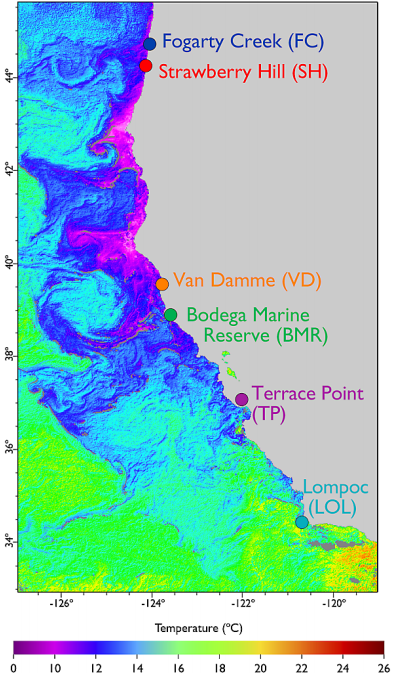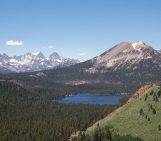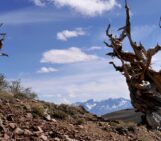In the latest Geosciences Column Sara Mynott sheds light on recent research into how ocean acidification is affecting the California Current Large Marine Ecosystem. The findings, published in Biogeosciences, reveal large differences between the abilities of different animals to adapt and highlight the urgent need to understand the way a greater suite of species are responding…
Large Marine Ecosystems (LMEs) are highly productive ocean areas that border the continents. To give you a flavour of just how productive we’re talking, together the world’s LMEs account for 80% of the global marine fisheries catch, making them incredibly important regions both socially and economically. The California Current Large Marine Ecosystem (CCLME) is one such system and covers the length of the US Pacific coast. But, like other ocean ecosystems, the CCLME is under threat from climate change.
Major changes in the carbonate chemistry of the oceans are expected over the next few decades, and changes in the California Current system are to be some of the most rapid. Determining how this system, and indeed other ecosystems, will respond is a significant challenge for biologists, ecologists and climate scientists alike.
In 2010, an interdisciplinary research group known as OMEGAS (Ocean Margin Ecosystems Group for Acidification Studies) set out to find answers by monitoring a ~1300 km stretch of the CCLME that runs from central Oregon to southern California. Because this stretch of ocean can be divided into distinct areas with differing pH and carbonate chemistry, the researchers could compare the characteristics of animals living in more acidic conditions with those living in a less acidic environment and assess their ability to adapt.
Like other LMEs, the California Current system is characterised by upwelling – a process that brings nutrient-rich deep water to the surface. Upwelling waters bring with them a change in pH. In the southern CCLME, there is regular upwelling but in the north it is intermittent. This means animals living off the Oregon coast experience more variable pH, and are exposed to lower pH water more often. By comparing animals in the north with those in the south of the study area, the OMEGAS scientists could effectively peer into the ecosystem’s future. The scientists were substituting space for time.

The California Current Large Marine Ecosystem, showing the sites monitored by OMEGAS for changes in the region’s biology and chemistry. Seawater is coloured according to temperature and land is shown in grey. (Credit: Hoffman et al., 2014)
By matching measurements of ocean properties, including pH, temperature and the amount of CO2 in the water, with information about the way different animals are responding to acidity (e.g. growth rate, shell thickness) and their genetic variation, the team are putting together a picture of how acidification is likely to affect the ecosystem in the future. One such animal is the purple sea urchin, a conspicuously bright spiny mass found throughout the CCLME, and an important control on the amount of algae carpeting the coast.
When peering at their skeletons for signs of acidification-related stress, the OMEGAS team found that the urchins differed little between sites – they were all tolerant of the pH range experienced across the CCLME. Urchin larvae travel large distances, rendering populations relatively homogeneous, so it isn’t too surprising. Taking a look at another ecologically important species, the Californian mussel, the team found that they were also made of hardy stuff, as growth in adult mussels was not reduced in low pH regions.
The news wasn’t all good though. A series of complementary experiments revealed that mussel larvae exposed to low pH water showed a decline in both growth and shell strength, similar to that seen in other young marine bivalves. Such a weakness would leave them more susceptible to attack from predators and, as ocean acidification continues, means they will become yet more vulnerable to predation in the future. Purple sea urchin larvae, on the other hand, could tolerate present day CO2 conditions, and higher levels had little influence on their growth and development. What’s more, studies of the sea urchin’s genetics revealed high genetic variation in the purple sea urchin population – a good indicator that they’d be able to adapt to future change.
The study highlights that the impact of acidification varies widely between species and a greater understanding of how ocean acidification will affect a variety of marine organisms is urgently needed. The OMEGAS team are now figuring out the capacity of other organisms in the CCLME to adapt, including coralline algae, a widely distributed algae with a calcium carbonate skeleton, making it highly vulnerable to ocean acidification.
The team are continuing their work in an effort to find refuges that may be relatively safe from future acidification, populations and life stages that are particularly vulnerable and those that are able to adapt to the rate of change our oceans are currently experiencing. Understanding how multiple species can adapt is critical to creating a coherent picture of how acidification will affect regions such as the CCLME in the future.
By Sara Mynott, PhD Student, University of Exeter
Reference:
Hofmann, G. E., Evans, T. G., Kelly, M. W., Padilla-Gamiño, J. L., Blanchette, C. A., Washburn, L., Chan, F., McManus, M. A., Menge, B. A., Gaylord, B., Hill, T. M., Sanford, E., LaVigne, M., Rose, J. M., Kapsenberg, L., and Dutton, J. M.: Exploring local adaptation and the ocean acidification seascape – studies in the California Current Large Marine Ecosystem, Biogeosciences, 11, 1053-1064, doi:10.5194/bg-11-1053-2014, 2014.







Pingback: Geosciences Column: Adapting to acidification, scientists add another piece to the puzzle | Ocean acidification